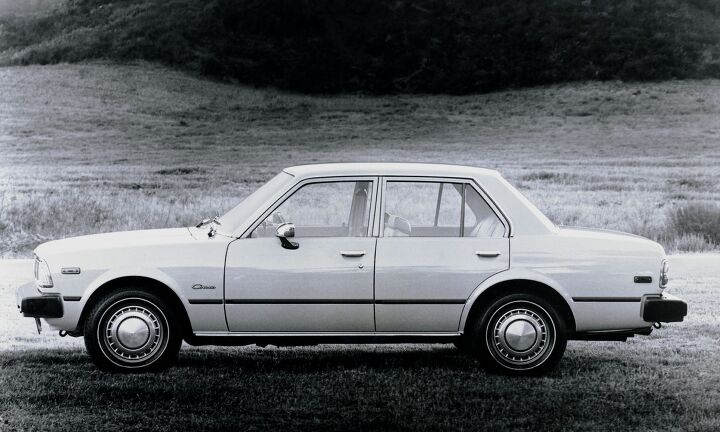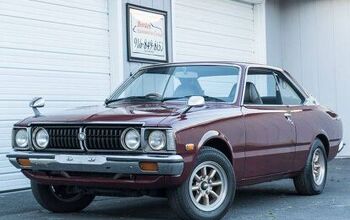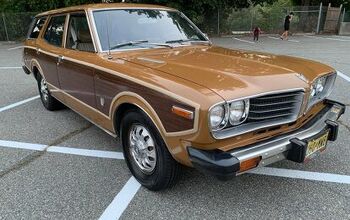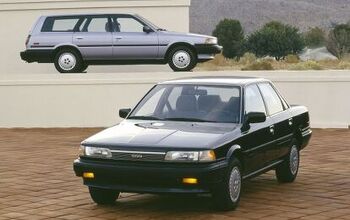Rare Rides: The 1980 Toyota Corona, a Camry Predecessor

Today’s Corona is the third to appear in the Rare Rides series. We started in early 2020 with a 1968 Corona Coupe and followed up that October with a Mark II wagon. Today’s entrant is from the last time North Americans could buy one.
Toyota changed Corona’s positioning more than once over its tenure, which included its placement in North America. Originally the Corona was a luxury model, second to Toyota’s flagship the Crown. The Coupe linked above was produced toward the end of Corona’s time as a luxury car, which lasted until 1970. At that point, the Corona Mark II arrived and Toyota expanded Corona name usage but pushed the original Corona down market. The larger, fancier Mark II was allowed to share features with the Crown and received its own platform in 1972.
That platform is where the Mark II wagon we featured previously arrived. The Mark II was on sale from 1969 through 1976 in the North American market, whereupon its third generation in 1978 it was renamed Cressida in North America. The lesser Corona was still on sale in the US and Canada and was still in its fifth-generation guise that debuted in 1973. Corona was Toyota’s compact offering, with Cressida playing a more upscale midsize role.
Production of a new sixth-gen T130 Corona started in 1978, and it arrived as a 1979 model in North America. Toyota decided to ditch the more rounded (yet still boxy) look of the fifth-gen car and go more square, upright, and formal. The size of the Corona sedan remained about the same as before at around 168 inches long, but the wagon version was now much closer in size to the sedan. In its prior generation, the wagon was nearly 9 inches longer than the sedan, but in T130 guise it was just 3 inches longer.
It was still the era of multiple body styles under a single nameplate, so Corona was offered with two doors as a hardtop, four doors as a sedan, and five doors as a liftback and wagon. The liftback was a new body style for Corona, as was the car’s naming in Japan. Home market customers saw Corona as a Toyota now, instead of a Toyopet. North America received all body styles except the coupe. Notable advances on the new Corona were an independent MacPherson strut front suspension and a trailing arm rear with a Panhard rod. Wagons across the Toyota lineup were more basic in their rear suspensions and used leaf springs. Front disc brakes were standard, and rear brakes were drums except on sporty models (not available in North America).
The Corona’s popularity had increased in North America with the fuel crisis, as the four-cylinder compact sedans were efficient and reliable at a time when domestic manufacturers were still playing catch up. Engines varied widely by market, as Corona used 13 different ones globally. All power was of inline-four configuration and ranged in displacement from 1.6 to 2.4 liters. Several different transmissions were used as well: Manuals had three, four, or five forward speeds. Automatics had three or four speeds.
In the middle of its model run, Corona received a facelift. The most notable change was quad headlamps, tilted slightly rearward to make the conservative Corona look more modern. Worth noting, the quad lamps were always used in North America, while other markets used single composite headlamps. The rear end was slightly updated as well. Toyota reserved the best for facelifted North American Coronas and offered only the five-speed manual or four-speed automatic, and larger engines.
The only engine on offer in the US and Canada at first was the 2.2-liter 20R engine from the Truck, but that was replaced with the 1981 facelift with the 2.4-liter 22R engine, also from the Truck. Horsepower was down in the emissions era and kept decreasing. The 2.0 started at 95 horses in 1979 and dropped to 90 in 1980. The 2.2 improved things to 96 horsepower in 1981.
Production continued on the T130 Corona through spring 1983, but 1982 was its last year in North America. For 1983 the Cressida was joined by a more modern and front-drive compact sedan that would make quite the impression on the market: Camry.
Today’s burgundy on burgundy Rare Ride is presently for sale in Michigan, where it miraculously appears to be rust-free. It’s a Luxury Edition trim and includes much velour and a vinyl roof. Manuel Transmisen will kindly accompany you on all journeys. This brougham sedan is yours for $7,500.
[Images: Toyota]

Interested in lots of cars and their various historical contexts. Started writing articles for TTAC in late 2016, when my first posts were QOTDs. From there I started a few new series like Rare Rides, Buy/Drive/Burn, Abandoned History, and most recently Rare Rides Icons. Operating from a home base in Cincinnati, Ohio, a relative auto journalist dead zone. Many of my articles are prompted by something I'll see on social media that sparks my interest and causes me to research. Finding articles and information from the early days of the internet and beyond that covers the little details lost to time: trim packages, color and wheel choices, interior fabrics. Beyond those, I'm fascinated by automotive industry experiments, both failures and successes. Lately I've taken an interest in AI, and generating "what if" type images for car models long dead. Reincarnating a modern Toyota Paseo, Lincoln Mark IX, or Isuzu Trooper through a text prompt is fun. Fun to post them on Twitter too, and watch people overreact. To that end, the social media I use most is Twitter, @CoreyLewis86. I also contribute pieces for Forbes Wheels and Forbes Home.
More by Corey Lewis
Latest Car Reviews
Read moreLatest Product Reviews
Read moreRecent Comments
- Kjhkjlhkjhkljh kljhjkhjklhkjh A prelude is a bad idea. There is already Acura with all the weird sport trims. This will not make back it's R&D money.
- Analoggrotto I don't see a red car here, how blazing stupid are you people?
- Redapple2 Love the wheels
- Redapple2 Good luck to them. They used to make great cars. 510. 240Z, Sentra SE-R. Maxima. Frontier.
- Joe65688619 Under Ghosn they went through the same short-term bottom-line thinking that GM did in the 80s/90s, and they have not recovered say, to their heyday in the 50s and 60s in terms of market share and innovation. Poor design decisions (a CVT in their front-wheel drive "4-Door Sports Car", model overlap in a poorly performing segment (they never needed the Altima AND the Maxima...what they needed was one vehicle with different drivetrain, including hybrid, to compete with the Accord/Camry, and decontenting their vehicles: My 2012 QX56 (I know, not a Nissan, but the same holds for the Armada) had power rear windows in the cargo area that could vent, a glass hatch on the back door that could be opened separate from the whole liftgate (in such a tall vehicle, kinda essential if you have it in a garage and want to load the trunk without having to open the garage door to make room for the lift gate), a nice driver's side folding armrest, and a few other quality-of-life details absent from my 2018 QX80. In a competitive market this attention to detai is can be the differentiator that sell cars. Now they are caught in the middle of the market, competing more with Hyundai and Kia and selling discounted vehicles near the same price points, but losing money on them. They invested also invested a lot in niche platforms. The Leaf was one of the first full EVs, but never really evolved. They misjudged the market - luxury EVs are selling, small budget models not so much. Variable compression engines offering little in terms of real-world power or tech, let a lot of complexity that is leading to higher failure rates. Aside from the Z and GT-R (low volume models), not much forced induction (whether your a fan or not, look at what Honda did with the CR-V and Acura RDX - same chassis, slap a turbo on it, make it nicer inside, and now you can sell it as a semi-premium brand with higher markup). That said, I do believe they retain the technical and engineering capability to do far better. About time management realized they need to make smarter investments and understand their markets better.






































Comments
Join the conversation
Minor correction: 20R = 2.2 liters, 22R = 2.4 liters.
Top model was Corona 2000GT with the 18R-G twin-cam engine that has a Yamaha-developed alloy cylinder head, twin Mikuni carburetors, and 9.7:1 compression, good for 140-150 rated horsepower. A 5-speed synchromesh gearbox and limited-slip differential delivered the power, with the Corona 2000 GT capable of reaching a top speed of 125 mph. Main competitor's were Datsun 240K GT and 180B SSS -models with Bosch fuel injection.